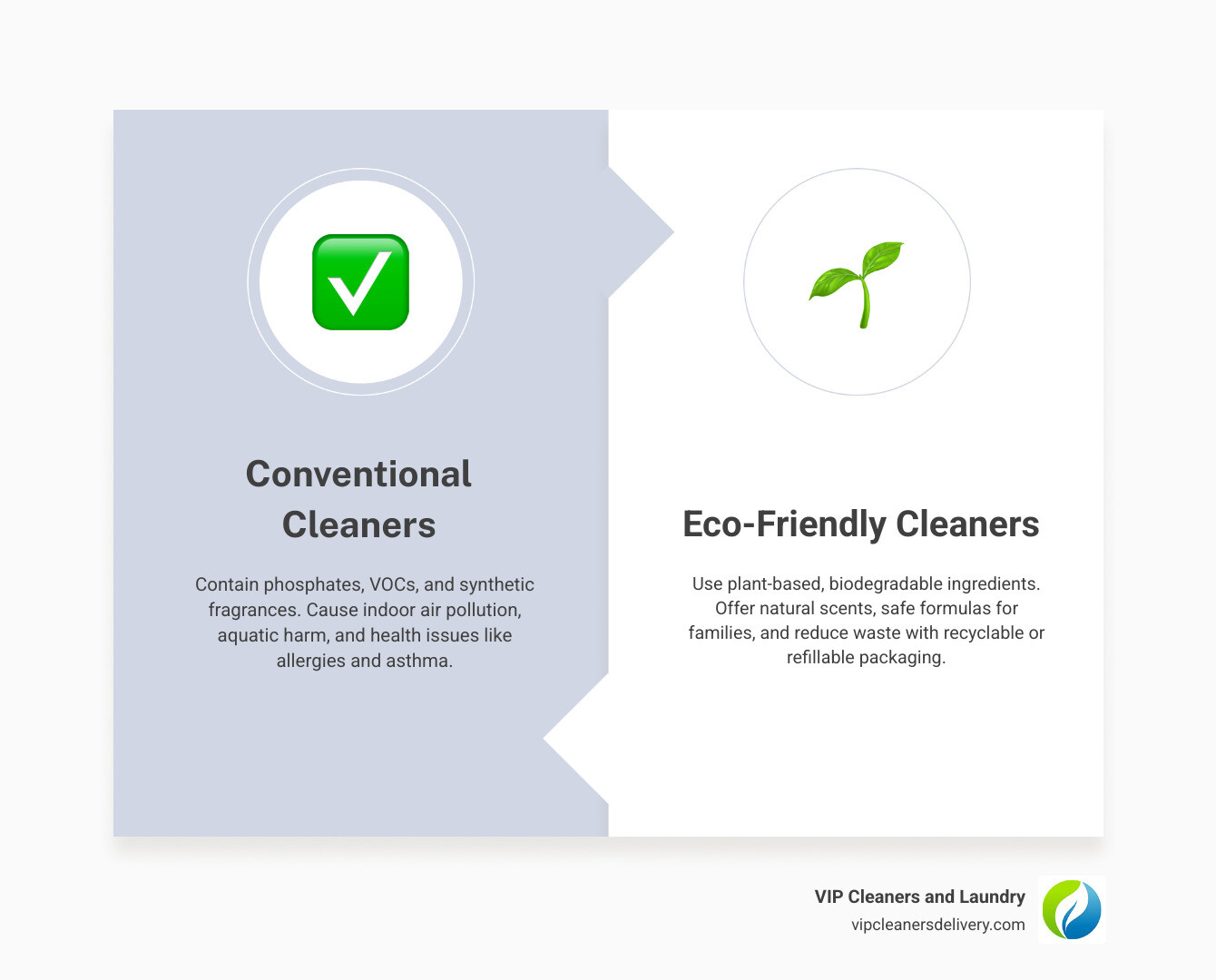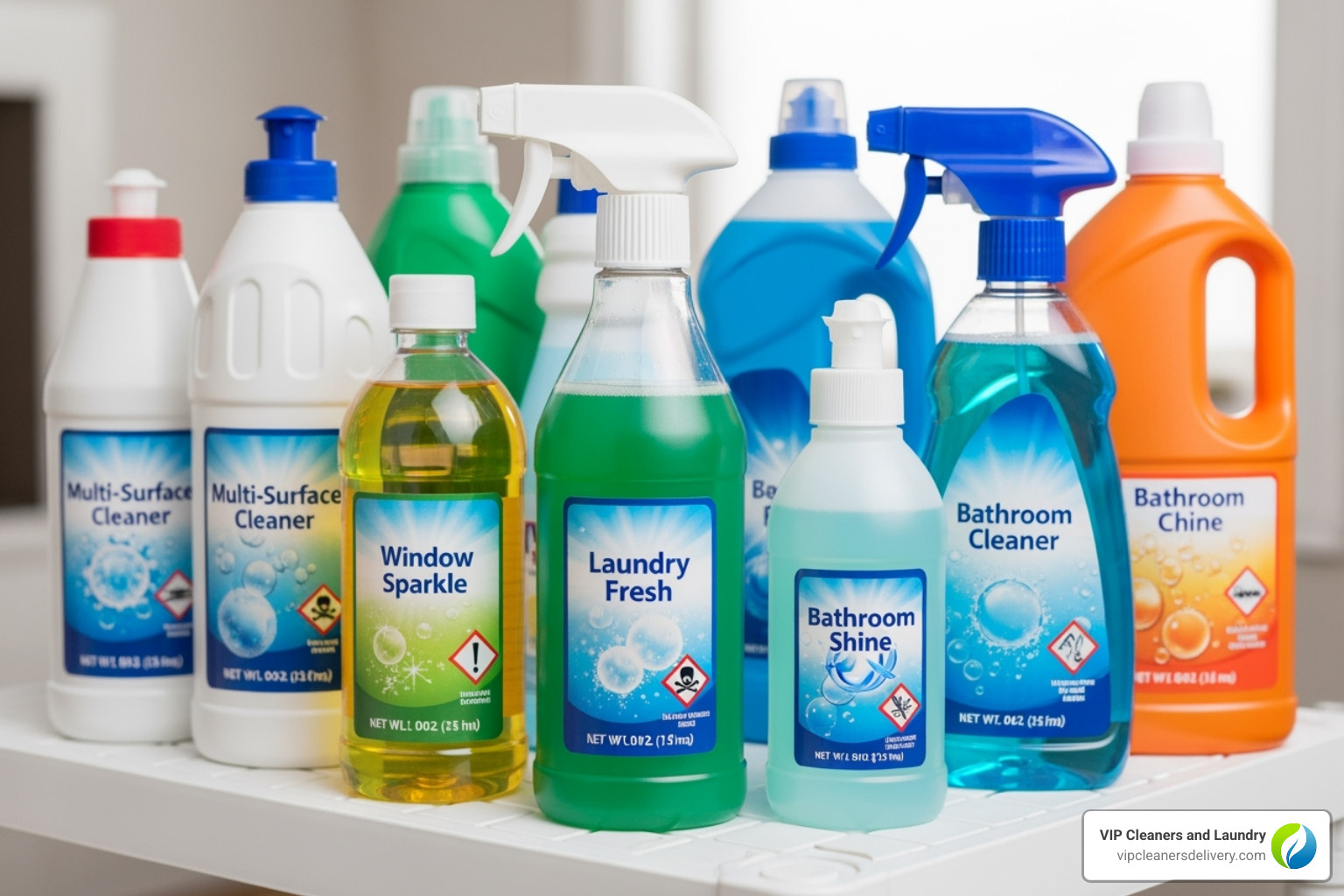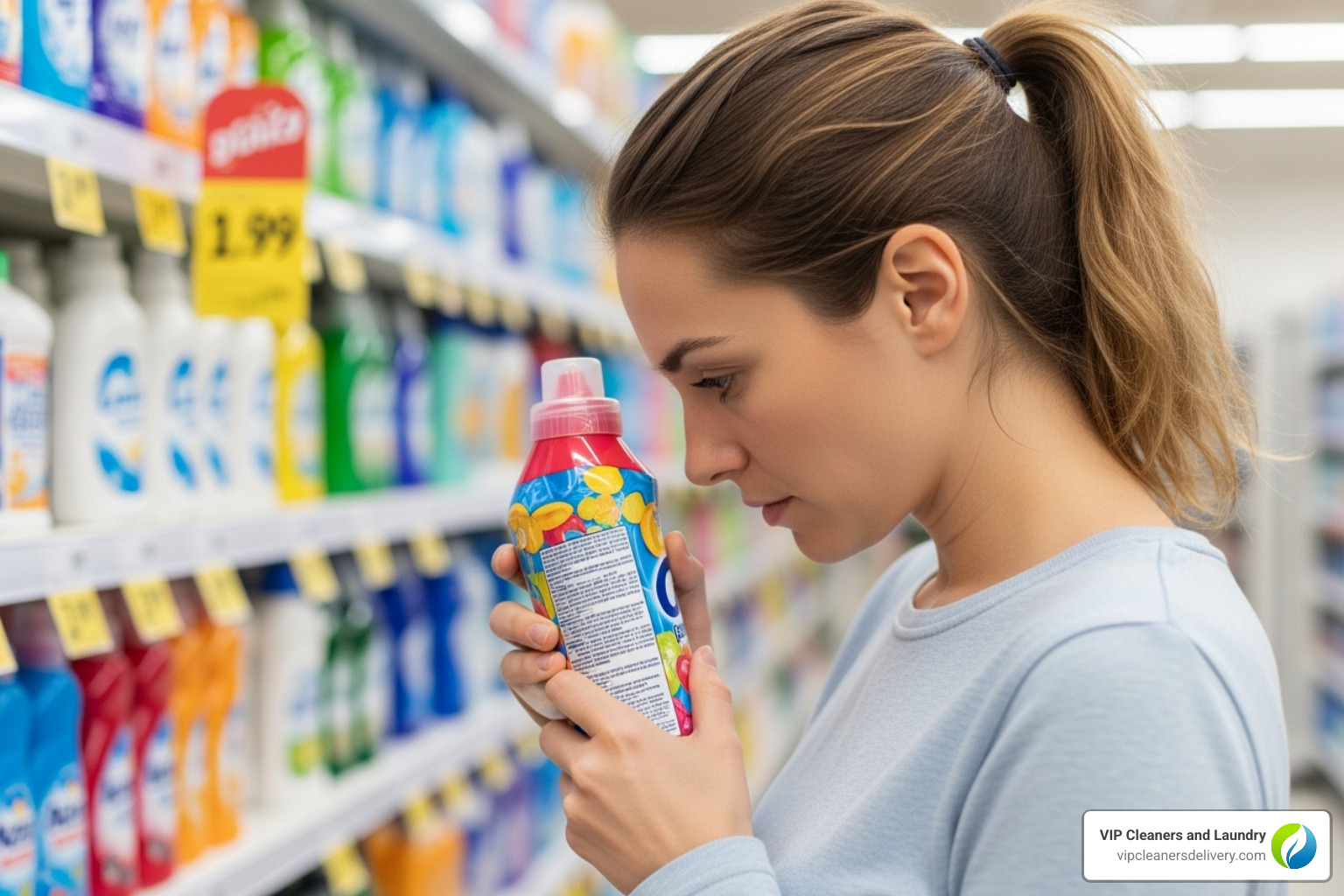Eco-friendly cleaning products: Sparkle Safe 2025
Your Guide to a Sparkling & Sustainable Home
Eco-friendly cleaning products are solutions made with plant-based, biodegradable ingredients that are safer for your health and the environment. When shopping, look for these key features:
- Plant-based surfactants and biodegradable formulas.
- Third-party certifications like EPA Safer Choice or EWG Verified®.
- Transparent ingredient lists with no hidden “fragrance.”
- Refillable or concentrated options to reduce plastic waste.
- Free from phthalates, triclosan, ammonia, and chlorine bleach.
Many conventional cleaners contain harmful chemicals linked to cancer, asthma, and allergies. Troublingly, many regions have lax labeling laws that don’t require warnings about chronic health hazards.
The good news is that switching to eco-friendly alternatives doesn’t mean sacrificing cleaning power. Modern green cleaners tackle tough grime while keeping your family safe and protecting waterways. Over 1,000,000 homes have already made the switch to brands that prioritize both effectiveness and sustainability.
This guide will help you find the best eco-friendly cleaning products for your needs, from ready-made solutions to DIY recipes. We’ll help you make informed choices that benefit your home and the planet.
I’m Salvador Villarreal, owner of VIP Cleaners and Laundry. With over 25 years of experience in sustainable cleaning, I’ve helped thousands of San Diego clients maintain spotless homes while minimizing environmental impact.

Why Go Green? The Hidden Dangers in Conventional Cleaners
That “clean” smell from conventional products often comes from chemicals that leave behind invisible residues. These substances linger on surfaces, evaporate into the air we breathe, and can contribute to respiratory issues, skin irritation, and more serious health concerns over time.
What’s troubling is that labeling laws often don’t require full disclosure of chronic health or environmental hazards. A 2012 survey found that fewer than half of home cleaners displayed a full ingredient list, leaving consumers in the dark.
The environmental impact is also significant. When rinsed down the drain, these chemicals threaten aquatic life and disrupt ecosystems. Phosphates cause algal blooms that create dead zones in waterways, while volatile organic compounds (VOCs) contribute to smog.
Switching to eco-friendly cleaning products addresses these concerns. You protect your family’s health, improve indoor air quality, and keep toxic chemicals out of our water systems without sacrificing cleanliness.

Harmful Chemicals to Avoid
Knowing which ingredients to avoid is half the battle. Here are some of the worst offenders:
- Phthalates: Endocrine disruptors often hidden in the term “fragrance” or “parfum.”
- Triclosan: Found in antibacterial cleaners, it’s linked to antibiotic resistance and harms aquatic life.
- Ammonia: A powerful degreaser, but its fumes can irritate the lungs and eyes. Never mix it with bleach.
- Chlorine Bleach: A strong disinfectant that causes respiratory irritation. Its residues can be absorbed through the skin. Never mix with anything but water.
- Quaternary Ammonium Compounds (QUATs): Respiratory irritants found in disinfectants and fabric softeners, linked to asthma.
- Volatile Organic Compounds (VOCs): Airborne chemicals that contribute to indoor and outdoor air pollution.
- Synthetic Fragrances & Dyes: Can trigger allergies and may be contaminated with heavy metals. Look for products scented with essential oils or no scent at all.
Other ingredients to watch for include optical brighteners, parabens, and phosphates. For more details, the Cleveland Clinic provides excellent resources on health risks of household chemicals.
Key Ingredients in Effective Eco-Friendly Cleaning Products
You don’t need harsh chemicals for a sparkling clean. Nature provides a powerful toolkit:
- Plant-based surfactants: The workhorses of green cleaners, they break down dirt and grease effectively and come from renewable sources.
- Vinegar & Baking Soda: Pantry superstars. Vinegar’s acidity cuts grease and deodorizes, while baking soda is a gentle abrasive and odor absorber.
- Castile Soap: A mild, biodegradable soap made from vegetable oils that’s tough on dirt.
- Hydrogen Peroxide: A gentler alternative to chlorine bleach for sanitizing surfaces.
- Essential Oils: Provide natural scents and can have disinfectant properties (e.g., tea tree and lavender).
- Citric Acid, Enzymes, Washing Soda, and Borax: These ingredients are natural powerhouses for descaling, breaking down specific stains, and tackling tough grease.
How to Choose the Best Eco-Friendly Cleaning Products
Walking down the cleaning aisle can be overwhelming. Many products are “greenwashed”—marketed with vague terms like “eco-safe” or “natural” without proof. These misleading labels make us feel like we’re making a good choice, but they don’t tell us what’s actually inside the bottle. To truly protect our families and the planet, we need transparency and facts, not just pretty packaging.

Understanding Certifications and Labels
Independent organizations have created certification programs that hold products to strict standards. Spotting these labels allows you to shop with confidence:
- EWG Verified® mark: This seal from the Environmental Working Group means every ingredient has been disclosed and vetted against their strictest health standards.
- EPA Safer Choice Standard: The U.S. Environmental Protection Agency certifies products with safer chemical ingredients that don’t sacrifice performance.
- Leaping Bunny: This certification guarantees that no animal testing was used in developing the product or its ingredients.
- Green Seal: This seal evaluates a product’s entire lifecycle, from manufacturing to disposal, considering both health and environmental impacts.
- Biodegradability (OECD 301): Look for this standard to ensure the product breaks down quickly in aquatic environments, protecting marine life.
Beyond seals, reading ingredient lists is crucial. Transparent companies provide complete lists with clear chemical names, not vague terms. If a brand is hiding what’s inside, it’s best to walk away.
Spotting “Greenwashing” vs. Genuinely Eco-Friendly Products
Here’s how to cut through the marketing fluff and find genuinely eco-friendly products:
- Look for specifics, not buzzwords. A real eco-friendly cleaner will say it contains “plant-based surfactants,” not just that it’s “natural.”
- Prioritize third-party verification. Seals like EWG Verified® and EPA Safer Choice are your best friend. Without them, green claims are just marketing.
- Question what “natural” means. Some natural substances can be allergens or unsustainably harvested. Ask for more information beyond just the “natural” claim.
- Assess the packaging. Genuinely eco-friendly brands use minimalist, recycled, or recyclable packaging. Refillable systems and concentrated formulas are even better.
- Research the company’s mission. Brands that walk the talk are transparent about their manufacturing, sourcing, and environmental goals. A clear mission backed by action is more telling than any leafy logo.
The Power of DIY: Simple & Effective Homemade Cleaners
Creating your own cleaning solutions is empowering. You know exactly what’s in them, you save money, and you avoid plastic waste. A few simple ingredients from your pantry can replace dozens of specialized, expensive cleaners.
Homemade cleaners are gentler on your skin and respiratory system, making them safer for homes with kids and pets. While they are fantastic for everyday cleaning—cutting grease and removing grime—they are not typically strong enough to disinfect against serious pathogens. For those needs, use an EPA-approved disinfectant. But for regular sparkle and shine, DIY is a great way to go.

DIY Recipes for Eco-Friendly Cleaning Products
These simple, effective recipes have been customer favorites for years.
All-Purpose Spray
Perfect for countertops, sinks, and most hard surfaces.
- In a spray bottle, combine 1/4 cup of white vinegar and 2 cups of boiled or distilled water.
- Add 1 tsp of liquid castile soap for extra degreasing.
- Add 12-20 drops of an essential oil like lemon (for scent) or tea tree (for antibacterial properties).
- Shake gently before use, spray, and wipe clean.
Window Cleaner
For a streak-free shine on glass surfaces.
- Mix 3 tbsp of white vinegar with 1 quart of water in a spray bottle.
- Spray on glass and wipe with a microfiber cloth. For best results, clean on a cloudy day to prevent the solution from drying too quickly.
Toilet Bowl Cleaner
The fizzing action of this mix lifts stains and neutralizes odors.
- Sprinkle 1/4 cup of baking soda into the toilet bowl.
- Pour 1 cup of white vinegar over the baking soda and let it fizz for 15-30 minutes.
- Scrub with a toilet brush and flush.
Soft Scrubbing Paste
A gentle abrasive for tubs, sinks, and chrome fixtures.
- Mix 1/2 cup of baking soda with enough liquid castile soap (1-2 tbsp) to form a thick paste.
- Add 5-10 drops of lemon essential oil for extra cleaning power.
- Apply with a damp cloth, scrub gently, and rinse thoroughly.
Safety Reminders: Always label your homemade cleaners clearly. Store them away from children and pets. Most importantly, never mix bleach with anything other than water, especially not with ammonia or acids like vinegar, as this creates dangerous toxic fumes. Make small batches, as homemade cleaners can lose effectiveness over time.
Beyond the Bottle: Innovative Zero-Waste & Refillable Options
If DIY isn’t for you, the market for eco-friendly cleaning products has evolved to offer convenient zero-waste and refillable options. These solutions tackle the huge environmental problem of single-use plastic waste.
Refillable systems offer clear benefits: reduced plastic waste, a lower carbon footprint from shipping less water, space-saving storage, and cost savings over time. While the initial reusable bottle may cost more, the refills are typically much cheaper.
How Refillable Systems Work
Modern refillable systems are simple and effective, challenging the idea that cleaners must come in new plastic every time.
- Cleaning tablets and powder concentrates: Simply drop a concentrated tablet or add powder to a reusable spray bottle with tap water. This creates a full bottle of powerful cleaner without the plastic waste.
- Reusable “forever” bottles: Made from durable glass, aluminum, or sturdy plastic, these bottles are designed to be refilled countless times.
- Water-activated formulas: By shipping only the active ingredients, companies avoid transporting water, making the entire process more efficient and eco-friendly.
- Subscription services: Many brands offer convenient subscription services for refills, often with discounts, ensuring you never run out.
These systems prove that we don’t have to sacrifice convenience to be eco-conscious.

Embracing a Sustainable Cleaning Routine
Beyond the products you use, small changes in your cleaning habits can make a big difference.
- Use microfiber cloths: They can clean most surfaces effectively with just water, reducing the need for cleaning sprays.
- Switch to reusable “unpaper” towels: Ditch single-use paper towels for washable cloth alternatives.
- Use wool dryer balls: They replace chemical-laden dryer sheets, soften clothes, and reduce drying time.
- Wash laundry in cold water: Most modern detergents work well in cold water, which saves a significant amount of energy.
- Reduce microfiber pollution: Use a special laundry bag or filter to trap tiny plastic fibers shed from synthetic clothing.
- Choose energy-efficient appliances and air-dry clothes when possible to save energy.
- Use less detergent: Concentrated formulas require only a small amount. Using too much can leave residue and waste product.
For items needing professional care, choose a service that shares your values. At VIP Cleaners, our Eco-Friendly Laundry Service ensures your garment care remains sustainable. Learn more in The Ultimate Guide to Eco-Friendly Dry Cleaning in Sunny San Diego.
Frequently Asked Questions about Eco-Friendly Cleaning
Making the switch to greener cleaning can bring up questions. Here are answers to the most common ones.
Are eco-friendly cleaning products as effective as conventional ones?
Yes, absolutely. We’ve been conditioned to associate harsh chemicals with cleaning power, but modern eco-friendly cleaning products work brilliantly. Nature-derived ingredients like plant-based surfactants effectively break down oils and lift dirt. Bio-enzyme formulas are specifically designed to break down tough protein-based stains. Many brands undergo rigorous testing to prove their performance matches or exceeds conventional cleaners, and the positive reviews from millions of households confirm their effectiveness. It’s all about choosing the right green product for the job.
Can I disinfect my home with natural products?
This is an important distinction. Cleaning removes dirt and germs, while disinfecting kills specific pathogens. For everyday cleaning, natural products are fantastic. Some natural ingredients, like hydrogen peroxide and tea tree oil, do have antimicrobial properties. A combination of vinegar followed by hydrogen peroxide (used separately) can sanitize many surfaces.
However, for serious health concerns or to kill specific viruses like the one that causes COVID-19, it’s best to use an EPA-approved disinfectant. The EPA’s Safer Choice program even certifies some antimicrobial products that meet health and environmental standards. Our advice: focus on thorough daily cleaning and use targeted disinfection on high-touch surfaces only when necessary.
Is it more expensive to use eco-friendly cleaners?
Not necessarily, especially in the long run. While some premium brands may have a higher upfront cost, many green options save you money. Concentrated formulas and refillable systems are highly cost-effective because you aren’t paying for water or single-use plastic packaging with every purchase. Refills almost always cost less than buying a new bottle. Furthermore, DIY cleaners made from pantry staples like vinegar and baking soda cost just pennies per bottle.
Many brands also offer subscription discounts that make green cleaning even more affordable. When you factor in the potential health savings from reduced chemical exposure, the value becomes even clearer. Going green can be gentle on your wallet as well as the planet.
Conclusion: Accept a Cleaner, Greener Home
From understanding the dangers of conventional cleaners to finding the power of simple, natural ingredients, you now have the knowledge to create a healthier, more sustainable home. The journey to using eco-friendly cleaning products is about making thoughtful choices that align with your values.
When we choose plant-based ingredients, biodegradable formulas, and refillable systems, we protect our families’ health, safeguard our waterways, and reduce plastic waste. These are meaningful contributions to a healthier planet. This shift is accessible to everyone, whether you prefer DIY solutions, certified ready-made products, or innovative refill systems. Over 1,000,000 homes have already successfully made the switch, proving that effectiveness and sustainability can go hand-in-hand.
Of course, some items like delicate fabrics and formal wear need professional attention. Choosing a service that shares your commitment to sustainability is key. Here at VIP Cleaners and Laundry in San Diego, CA, we’ve spent over 25 years perfecting eco-friendly methods. We offer free pickup and delivery to make your green lifestyle completely seamless.
Every choice matters. Each time you reach for a safer cleaner, you’re voting for a healthier world. Start today—mix a DIY spray, order your first cleaning tablets, or simply read a label more carefully. For garments that need expert care, see how our Eco-Friendly Laundry Service can help. You can also learn more about our eco-friendly dry cleaning options to complete your green routine.
Welcome to a cleaner, greener way of living. You deserve the peace of mind that comes with knowing your choices are making a real difference.






